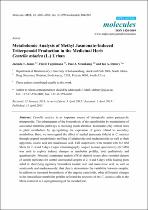 ResearchSpace
ResearchSpace
Metabolomic analysis of methyl jasmonate-Induced triterpenoid production in the medicinal herb Centella asiatica (L.) Urban
JavaScript is disabled for your browser. Some features of this site may not work without it.
- ResearchSpace
- →
- Research Publications/Outputs
- →
- Journal Articles
- →
- View Item
| dc.contributor.author |
James, TJ

|
|
| dc.contributor.author |
Tugizimana, F

|
|
| dc.contributor.author |
Steenkamp, PA

|
|
| dc.contributor.author |
Dubery, IA

|
|
| dc.date.accessioned | 2013-06-25T07:24:05Z | |
| dc.date.available | 2013-06-25T07:24:05Z | |
| dc.date.issued | 2013-04 | |
| dc.identifier.citation | James, TJ, Tugizimana, F, Steenkamp, PA and Dubery IA. 2013. Metabolomic analysis of methyl jasmonate-induced triterpenoid production in the medicinal herb Centella asiatica (L.). Molecules, vol. 18, pp 4267-4281 | en_US |
| dc.identifier.issn | 1420-3049 | |
| dc.identifier.uri | http://hdl.handle.net/10204/6837 | |
| dc.description | Copyright: 2013 MDPI AG. This is the definitive version of the work. | en_US |
| dc.description.abstract | Centella asiatica is an important source of biologically active pentacyclic triterpenoids. The enhancement of the biosynthesis of the centellosides by manipulation of associated metabolic pathways is receiving much attention. Jasmonates play critical roles in plant metabolism by up-regulating the expression of genes related to secondary metabolites. Here, we investigated the effect of methyl jasmonate (MeJa) in C. asiatica through targeted metabolomic profiling of asiaticoside and madecassoside as well as their aglycones, asiatic acid and madecassic acid. Cell suspensions were treated with 0.2 mM MeJa for 2, 4 and 6 days. Liquid chromatography coupled to mass spectrometry (LC-MS) was used to explore induced changes in metabolite profiles, both qualitatively and quantitatively. Principal component analysis (PCA)-derived scores plots revealed clusters of sample replicates for control and treated samples at 2, 4 and 6 days while loading plots aided in identifying signatory biomarkers (asiatic acid and madecassic acid, as well as asiaticoside and madecassoside) that clearly demonstrate the variability between samples. In addition to increased biosynthesis of the targeted centelloids, other differential changes in the intracellular metabolite profiles reflected the response of the C. asiatica cells to the MeJa-treatment as a reprogramming of the metabolom | en_US |
| dc.language.iso | en | en_US |
| dc.relation.ispartofseries | Workflow Request;10831 | |
| dc.subject | Centella asiatica | en_US |
| dc.subject | Centelloids | en_US |
| dc.subject | Triterpenoids | en_US |
| dc.subject | Metabolic profiling | en_US |
| dc.subject | Metabolomics | en_US |
| dc.title | Metabolomic analysis of methyl jasmonate-Induced triterpenoid production in the medicinal herb Centella asiatica (L.) Urban | en_US |
| dc.type | Article | en_US |
| dc.identifier.apacitation | James, T., Tugizimana, F., Steenkamp, P., & Dubery, I. (2013). Metabolomic analysis of methyl jasmonate-Induced triterpenoid production in the medicinal herb Centella asiatica (L.) Urban. http://hdl.handle.net/10204/6837 | en_ZA |
| dc.identifier.chicagocitation | James, TJ, F Tugizimana, PA Steenkamp, and IA Dubery "Metabolomic analysis of methyl jasmonate-Induced triterpenoid production in the medicinal herb Centella asiatica (L.) Urban." (2013) http://hdl.handle.net/10204/6837 | en_ZA |
| dc.identifier.vancouvercitation | James T, Tugizimana F, Steenkamp P, Dubery I. Metabolomic analysis of methyl jasmonate-Induced triterpenoid production in the medicinal herb Centella asiatica (L.) Urban. 2013; http://hdl.handle.net/10204/6837. | en_ZA |
| dc.identifier.ris | TY - Article AU - James, TJ AU - Tugizimana, F AU - Steenkamp, PA AU - Dubery, IA AB - Centella asiatica is an important source of biologically active pentacyclic triterpenoids. The enhancement of the biosynthesis of the centellosides by manipulation of associated metabolic pathways is receiving much attention. Jasmonates play critical roles in plant metabolism by up-regulating the expression of genes related to secondary metabolites. Here, we investigated the effect of methyl jasmonate (MeJa) in C. asiatica through targeted metabolomic profiling of asiaticoside and madecassoside as well as their aglycones, asiatic acid and madecassic acid. Cell suspensions were treated with 0.2 mM MeJa for 2, 4 and 6 days. Liquid chromatography coupled to mass spectrometry (LC-MS) was used to explore induced changes in metabolite profiles, both qualitatively and quantitatively. Principal component analysis (PCA)-derived scores plots revealed clusters of sample replicates for control and treated samples at 2, 4 and 6 days while loading plots aided in identifying signatory biomarkers (asiatic acid and madecassic acid, as well as asiaticoside and madecassoside) that clearly demonstrate the variability between samples. In addition to increased biosynthesis of the targeted centelloids, other differential changes in the intracellular metabolite profiles reflected the response of the C. asiatica cells to the MeJa-treatment as a reprogramming of the metabolom DA - 2013-04 DB - ResearchSpace DP - CSIR KW - Centella asiatica KW - Centelloids KW - Triterpenoids KW - Metabolic profiling KW - Metabolomics LK - https://researchspace.csir.co.za PY - 2013 SM - 1420-3049 T1 - Metabolomic analysis of methyl jasmonate-Induced triterpenoid production in the medicinal herb Centella asiatica (L.) Urban TI - Metabolomic analysis of methyl jasmonate-Induced triterpenoid production in the medicinal herb Centella asiatica (L.) Urban UR - http://hdl.handle.net/10204/6837 ER - | en_ZA |





